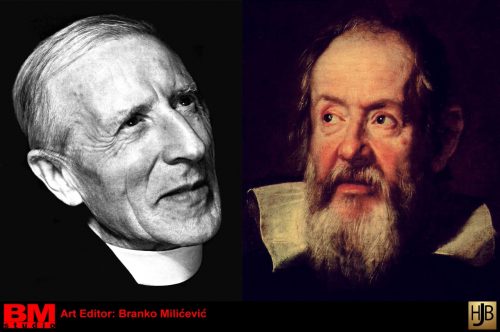Following the Powerpoint “Teilhard de Chardin, 20th Century Galileo,” that Frank and Mary Frost presented via Zoom last week, we thank our friend and Teilhard scholar H. James Birx for the following excellent summary comparing Teilhard and Galileo.

Galileo Galilei (1564-1642) & Pierre Teilhard de Chardin (1881-1955)
01. Each respected science, research, observation, empirical evidence, & critical reflection.
02. Each contributed to the natural sciences:
- Galileo to astronomy & physics.
- Teilhard to geology & paleontology.
03. Each authored a major but controversial book that was deemed to be unorthodox & therefore unacceptable by the Roman Catholic Church:
- Galileo‘s Dialogues Concerning the Two Chief World Systems (1632).
- Teilhard‘s The Phenomenon of Man (1955; it was banned from publication during his lifetime, but it was published posthumously.
04. Each was silenced by the Roman Catholic Church:
- Galileo, In 1633, under the threat of torture, was forced by the Inquisition to reject all his scientific discoveries in astronomy & placed under house arrest until his death in 1642.
- Teilhard was exiled from France to China by his Jesuit superiors & forbidden to teach or to publish his ideas on philosophy & theology; he could publish his strictly scientific papers. On 10 April 1955, Teilhard died in New York City.
05. However, each never abandoned the Roman Catholic Church.
06. Each rejected fixity;
- Galileo rejected both geocentrism & the fixity of the Earth, claiming that our rotating planet moves through space as it revolves around the Sun as the center of our solar system.
- Teilhard rejected the fixity of species (including the alleged fixity of the human animal), claiming that the fact of organic evolution demonstrates that new species emerge & that all species change throughout biological history, with most species having become extinct over vast periods of geological time; in fact, for Teilhard, this entire universe is a cosmogenesis.
07. Each made substantial contributions to natural science:
Using his telescope (which was far more powerful than those earlier versions used by others) for observational astronomy, Galileo had discovered:
- Spots on the Sun;
- Phases of Venus;
- Mountains & Craters on the Moon;
- Four largest moons of Jupiter;
- Rings of Saturn;
- “Star” Neptune;
- Stars of our Milky Way Galaxy.
Teilhard contributed to understanding & appreciating the geology & paleontology of the caves at Zhoukoudian near Bejing in China, especially in terms of the discovery of Peking Man (Sinanthropus pikenensis), a fossil hominid form now relegated to the Homo erectus phase of human evolution. He also contributed to the scientific study of Mongolia, as well as other significant anthropological sites. Teilhard did not hesitate to seriously consider the scientific implications, philosophical ramifications, & theological consequences of the fact of pervasive evolution.
08. As a result, both Galileo & Teilhard had made major contributions to natural philosophy through their research, which challenged the dogmatic & entrenched Aristotelian worldview while advancing a modern cosmology & anthropology, respectively, in terms of a dynamic view of this universe & the place of our own evolving species within it.
09. On 31 October 1992, the Vatican admitted that Galileo Galilei had been correct concerning his claims in astronomy.
However, the Vatican is yet to remove the “warning” (Monitum decree 1962) it has given to the writings of Pierre Teilhard de Chardin, S.J.
Prof. Dr. Dr. H. James Birx
Distinguished Visiting Professor (permanent status)
Faculty of Philology, University of Belgrade




